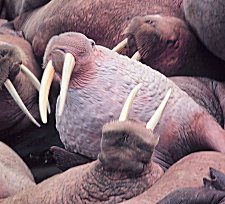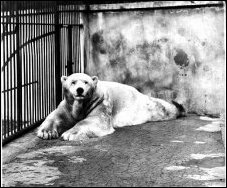| Seals, walruses and bears |
|
An alternative to whales Over-fishing in the Greenland Sea soon resulted in a scarcity of whales. This forced some whaling captains to hunt further afield, often in dangerous conditions, in the Davis Strait. They also diversified their operations, hunting polar bears, seals and walruses along the inlets and bays of Greenland and the Labrador coast. The bears were hunted for their skins and also captured alive for exhibition in zoos and menageries. The walrus provided ivory tusks which were in demand for carving decorative items as well as blubber. In the 19th century mills and factories were powered by water wheels or stationary steam engines. The power was transferred to the looms and other machinery by a system of shafts, pulleys and leather belts. Many of these belts were made from walrus leather. Seals were caught in large numbers, again for their skins and for their blubber. Like whales, seals face the problem that sea water is always colder than blood and heat is lost much more rapidly to water than to air. Seals need adaptations to avoid huge heat loss. Fur, which traps a layer of insulating air, is an effective insulator on land, but when a seal dives the fur is compressed by half its thickness for every 10 metres of depth, much reducing its efficiency. Seals overcome this problem by having a thick layer of blubber, up to 10 cm in thickness. |
| |

